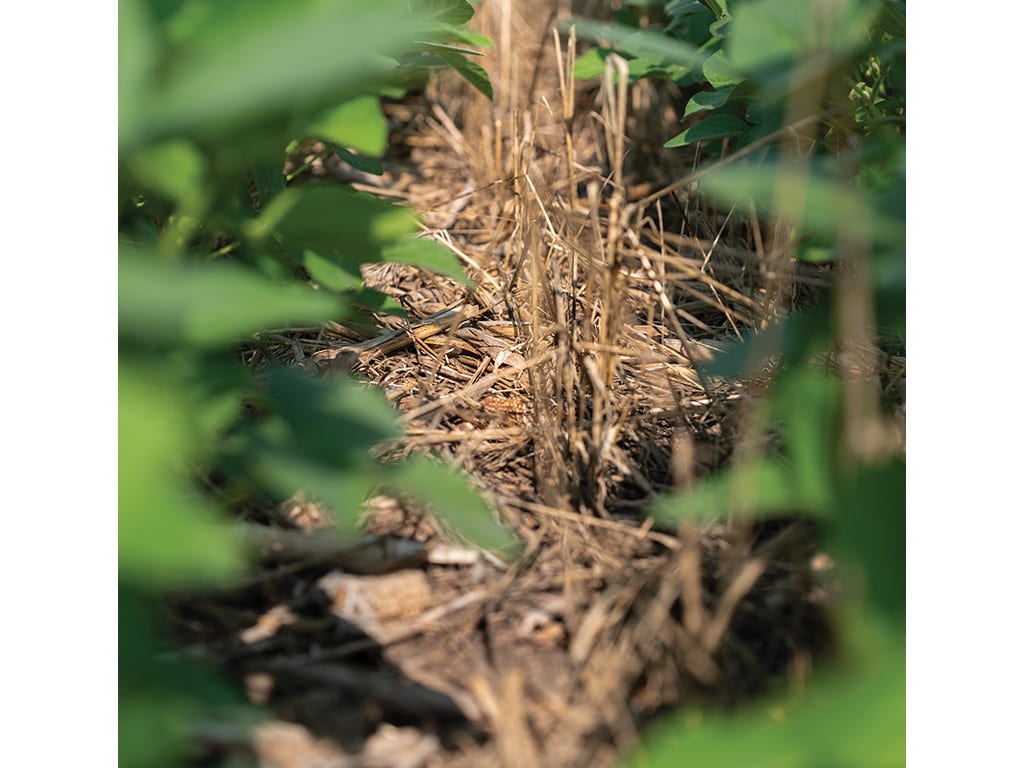Agriculture, Education September 01, 2024
How Weeds Are Changing
Some are developing resistance to herbicides they've never seen.
by Bill Spiegel
In a dusty field in central Kansas, Ted Bannister steps onto freshly-worked ground. Not long ago, Bannister would have no-tilled this land, using timely application of herbicides and growing crop canopy to keep weeds at bay.
Now? Weeds require iron.
Like many farmers, Bannister has come full circle. When he began farming just over two decades ago, he used tillage to control weeds. When glyphosate-tolerant crops were introduced in the mid-1990s, he adopted them like everyone else, and could combat weeds with one sprayer pass.
"I lived through the golden period of farming when you could kill anything with just Roundup herbicide," he recalls. "I could spray two-foot tall kochia, and by the time I folded the booms on my sprayer to leave the field the weeds were showing signs of dying."
In the early 2000s, herbicides were cheap and effective. Now, they are neither, he says.
"Honestly," Bannister laments, "I just want to kill a freaking weed."
What has happened. Palmer amaranth (also called pigweed) is resistant to eight sites of action, while kochia is resistant to two. These are prolific in Kansas, but farmers throughout the U.S. are flummoxed by all kinds of herbicide-resistant weeds.
Weeds that thrived despite being sprayed with herbicide were discovered as far back as the 1960s. But when Roundup Ready soybeans were commercialized in 1996, followed by Roundup Ready corn in 1998, a couple of things happened: more than 155 million acres of cropland were treated with Roundup by 2008, and weed resistance to glyphosate, the active ingredient in Roundup, had begun.
In 2000, Bob Hartzler, weed scientist at Iowa State University, wrote that resistance to glphosate was inevitable.
There are two types of resistance. "Target site resistance" occurs when the weed develops changes at the point on the plant where the herbicide is intended to cause its damage. It's a consequence of repeatedly using the same herbicide mode of action. "Metabolic resistance" is far more insidious because plants break herbicides down into harmless compounds that have no effect on the target.
The scary part? Weeds can develop resistance to herbicides that they have never seen.
In Kansas in 2021, researchers found Palmer amaranth that contained resistance to six herbicide sites of action, including some herbicides that had never been sprayed in the field. And in Champaign County, Illinois, the same year, weed scientists confirmed dicamba-resistant waterhemp, despite the waterhemp having never been sprayed with that herbicide.
"When we use herbicides, we select for plants that can survive those herbicides through a variety of mechanisms," says Pat Tranel, professor in the Department of Crop Sciences at the University of Illinois. "Historically, that was target-site mutation, but now, more and more, we're seeing metabolic resistance, where the weeds are activating detoxification genes before the chemicals can do harm. And so these weed populations are accumulating suites of genes that are active against various herbicides, and there's cross-reactivity."
As of May 2024, herbicide-resistant weeds are reported in 100 crops in 72 countries, and to 21 of the 31 known herbicide sites of action, according to the International Herbicide-Resistant Weed Database.
Relying solely on herbicides for weed control is no longer an option.
"We're not going to spray our way out of this problem," Hartzler says.
Above. In the Plains, kochia has developed resistance to sulfonylurea and triazine modes of action. A single kochia plant can prdouce 600,000 seeds. Illinois farmer Frank Rademacher aims to understand why weeds are thriving, and act aggressively in response. When herbicides no longer work, Kansas farmer Ted Bannister deploys a one-two punch of tillage and herbicides to suppress hard-to-control weeds. Illinois farmer Frank Rademacher is reducing chemical weed control in favor of cover crops. Soybeans grown into a thick canopy of cereal rye do a good job of suppressing herbicide-resistant weeds on Rademacher's farm in eastern Illinois.
What to do? Weed scientists agree: farmers need to think more holistically about weed control.
Adopting a program of using multiple, effective modes of action—including residual herbicides—is a good first step, Hartzler says.
Reducing the weed seed bank is also critical. In ideal conditions, single waterhemp and Palmer amaranth plants each may produce half a million seeds.
Sarah Lancaster, weed management specialist at Kansas State University, adds that growers could tweak cultural practices, including adopting narrow row spacing, increasing seeding rates, and adjusting planting dates to reduce weed emergence and growth, plus improve crop competitiveness. And, growers may need to adopt alternative control tactics, such as harvest weed seed control or weed electrocution.
Diversity is key, says Marty Williams, weed ecologist at the USDA Agricultural Research Service in Urbana, Illinois.
"The more we rely on an individual tactic, the more we selected for a phenotype that adapts to that tactic," he says. "I suspect the same could be said whether it's using robotic weeds or electricity, or whatever new great thing is coming, any over-reliance on them will shorten their shelf life."
Beating resistance. Illinois farmer Frank Rademacher has adopted a long-term strategy to address all kinds of threats to the farm he operates with his father Eric in Champaign County. Frank seeks to understand the opponent.
For instance, waterhemp thrives in fields with good fertility and when soils have been tilled. Waterhemp doesn't like residue, and doesn't thrive under competition, he says. As such, the Rademachers began using cover crops in 2013, and now all cash crops are planted into covers.
"Going forward, that will be the focal point: planting green and getting the most out of cover crops," Frank adds. "Hopefully we can get by without a post-emerge application. Sometimes it works out, and sometimes it doesn't. The longterm plan is to have a more reliable one-pass system."
For Bannister, who farms in an arid environment in central Kansas, cover crops use too much moisture and many farmers summer fallow after corn or grain sorghum harvest, prior to planting wheat the next fall. Tillage, herbicides, and competition are the only tools they can use.
"Start clean, rotate preemerge and pray we get a competitive crop," he says. "This is a battle." ‡
Read More

AGRICULTURE, EDUCATION
Outstanding Farmers of America
John Deere supports farmers passionate about agriculture.

AGRICULTURE, EDUCATION
The Mighty Moth
Tiny lepidoptera may be bigger pollinators than once thought.






